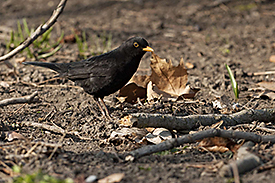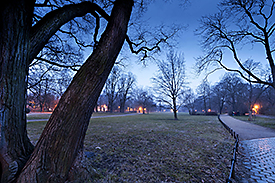Press release, October 20th, 2014
Later supper for blackbirds in the city
Artificial light gives birds longer to forage for food.
Leipzig. Artificial light increases foraging time in blackbirds. Birds in city centres are active not just considerably earlier, but also for longer than their relatives in darker parts of the city. That is the result of a study of around 200 blackbirds in Leipzig, which was carried out in the framework of the "Loss of the Night" research project. The study showed that artificial light has a considerable influence on the activity times of blackbirds in the city and therefore on their natural cycles, according to scientists of the Helmholtz Centre for Environmental Research (UFZ) and the Leipzig University, published in the specialist periodical Journal of Ornithology.

Artificial light increases foraging time in blackbirds. Birds in city centres are active not just considerably earlier, but also for longer than their relatives in darker parts of the city.
Photo: André Künzelmann, UFZ

Light does not just influence biorhythm of organisms in the city. Even in many conservation areas, the sky has become considerably lighter than originally at night, due to neighbouring cities.
Photo: André Künzelmann, UFZ
One year ago, the scientists were able to demonstrate that street noise and artificial light affect birds in the city centre of Leipzig to become active up to five hours earlier in the morning than their conspecifics in quieter, unlit parts of the city of Leipzig. The scientists chose the blackbird (Turdus merula) because this species of bird was originally a forest dweller, but has adjusted well to conditions in the city since the early 19th century. Since then, it has become widespread in cities and easily identifiable through its distinctive song. In the years 2011 to 2013, over 200 blackbirds were caught in an area in Leipzig covering 215 hectares, with the permission of the authorities. The research area covered a 3 km-long gradient oriented towards the South West, from the city centre, through the Clara Zetkin Park and to the seminatural remains of a floodplain forest called Leipziger Auwald. Due to the street lighting, it is considerably lighter in the green areas within the innercity ring-road than in the Auwald.
Caught birds were measured, individually ringed and released. On 35 days between March and July, some of them were specifically observed during their foraging activities. "On the short days in March, the blackbirds in the forest stopped foraging almost one hour before their counterparts in the well-lit city. The longer the days grew, the smaller the difference became. In the summer, there were just a few minutes' difference between city and forest birds," says Anja Ruß of UFZ.
The observations showed that in the illuminated city centre, the males are considerably more likely to be last to leave the foraging grounds, whilst there was no deviation from the general gender ratio in the forest. The researchers attributed this to the differing sensitivity to light of each sex. It is known that male blackbirds tend to be slightly larger than females. This is also true of their eyes. “Larger eyes lead to better vision in poor light conditions. This makes it easier for males to forage for food in the twilight than females. The artificial light in the city exacerbates this difference between the sexes even further, meaning that the males can remain active for longer in the evenings”, Dr Reinhard Klenke of UFZ explains.
The study underlines the fact that artificial light at night has a major part to play in the biorhythms of city blackbirds. It allows the birds to extend their daily activities. This effect, however, decreases with the lengthening of the days in summer. Contrary to earlier assumptions, city blackbirds do not appear to benefit physically from the artificial light and the extra time; the scientists were unable to establish a significant difference in physical conditions between the two groups during the period of extended foraging time. They therefore assume that as well as light, the availability and quality of food and the risk of being eaten are also important factors.
Whilst pollution of air, noise and water have been anchored in the minds of the public for a long time and have been scientifically researched to a corresponding extent, awareness of the problem of the loss of the natural darkness of the night due to artificial light and the far-reaching changes in natural processes is coming to the fore much more slowly. This is relevant not only for the natural ecosystems but is already affecting the human society considerably. Over the last three years, the interdisciplinary research project "Loss of the Night", led by the Leibniz Institute of Freshwater Ecology and Inland Fisheries (IGB), has carried out pioneering research. In the sub-project "BILL" (Birds in ILluminated Landscapes), a working group led by Dr Reinhard Klenke of UFZ was focusing on comparative studies of different influences of artificial light on bird populations. "There have already been several studies on the effects of light or noise on birds. For the first time, however, our study has analysed the complex interplay in the combination of the two factors, which create stress not only for us humans, but also for the animals of the city", the biologist emphasised. He was behind the original idea for the study and hopes to continue to study the effects on bird fitness.
Light does not just influence biorhythm of organisms in the city. Even in many conservation areas, the sky has become considerably lighter than originally at night, due to neighbouring cities. Human population growth
and growing urbanisation will exacerbate this problem in many regions of the world. On top of this come technological trends, such as the increasing use of LED lights with spectra partly different from those of natural light,
or the increasing use of light as a design element in the cityscape. This makes it all the more important for research to be carried out into the knock-on effects of these developments on humans and animals.
Tilo Arnhold
Publications:
Anja Russ, Annika Rüger, Reinhard Klenke (2014): Seize the night: European Blackbirds (Turdus merula) extend their foraging activity under artificial illumination.
Journal of Ornithology.
http://dx.doi.org/10.1007/s10336-014-1105-1
The study was supported by the Federal Ministry of Education and Research (BMBF) and by the Helmholtz Association in the framework of the graduate school HIGRADE.
Ommo Hüppop, Reinhard Klenke und Anja Nordt: Vögel und künstliches Licht
in: Thomas Posch, Franz Hölker, Thomas Uhlmann, Anja Freyhoff (Hrsg.): Das Ende der Nacht. Lichtsmog: Gefahren – Perspektiven – Lösungen.
Zweite, überarbeitete und erweiterte Auflage, September 2013. 232 Seiten, 50 Farbabb., Hardcover, WILEY-VCH, Weinheim, ISBN 978-3-527-41179-5
http://www.wiley-vch.de/publish/dt/books/ISBN978-3-527-41179-5/reviews/?sID=epdh39rjjcvm4mqtbr07l10175
Nordt A, Klenke R (2013) Sleepless in Town – Drivers of the Temporal Shift in Dawn Song in Urban European Blackbirds. PLoS ONE 8(8): e71476.
http://dx.doi.org/10.1371/journal.pone.0071476
Further information:
Dr Reinhard Klenke / Anja Ruß (née Nordt) / Annika Rüger
Helmholtz Centre for Environmental Research (UFZ)
Tel: ++49-341-235-1651
https://www.ufz.de/index.php?de=1923
https://www.ufz.de/index.php?de=20750
and
http://www.uni-leipzig.de/~agspzoo/
or via
Helmholtz Centre for Environmental Research (UFZ)
Tilo Arnhold, Susanne Hufe (UFZ press office)
Tel.: +49-(0)341-235-1635, -1630
Other links:
Artificial lighting and noise alter biorhythms of birds (press release dated 24 September 2013):
http://www.ufz.de/index.php?de=32043
Causes and Consequences of artificial night lighting for environment, nature and man – Loss of the night, effect of light pollution on birds
https://www.ufz.de/index.php?de=20772
http://www.verlustdernacht.de/
In the Helmholtz Centre for Environmental Research (UFZ), scientists conduct research into the causes and consequences of far-reaching environmental changes. Their areas of study cover water resources, biodiversity, the consequences of climate change and possible adaptation strategies, environmental technologies and biotechnologies, bio-energy, the effects of chemicals in the environment and the way they influence health, modelling and social-scientific issues. Its guiding principle: Our research contributes to the sustainable use of natural resources and helps to provide long-term protection for these vital assets in the face of global change. The UFZ employs more than 1,100 staff at its sites in Leipzig, Halle and Magdeburg. It is funded by the federal government, Saxony and Saxony-Anhalt.
The Helmholtz Association contributes to solving major and urgent issues in society, science and industry through scientific excellence in six research areas: Energy, earth and environment, health, key technologies, structure of matter as well as aviation, aerospace and transportation. The Helmholtz Association is the largest scientific organisation in Germany, with 35,000 employees in 18 research centres and an annual budget of around €3.8 billion. Its work is carried out in the tradition of the great natural scientist Hermann von Helmholtz (1821-1894).
